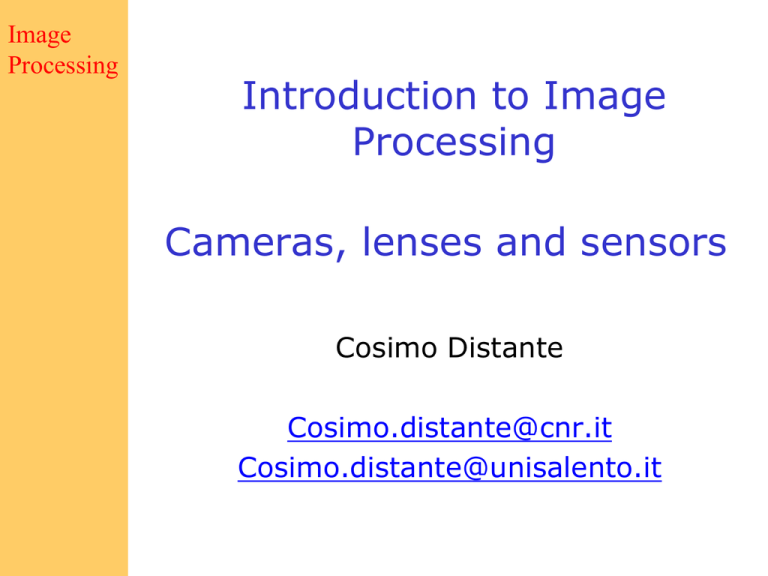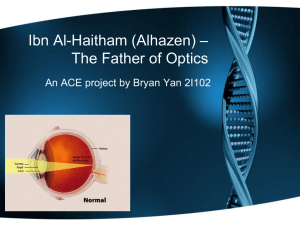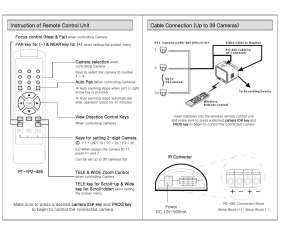Document
advertisement

Computer Image Vision Processing Introduction to Image Processing Cameras, lenses and sensors Cosimo Distante Cosimo.distante@cnr.it Cosimo.distante@unisalento.it Image Processing Cameras, lenses and sensors • Camera Models – Pinhole Perspective Projection • Camera with Lenses • Sensing • The Human Eye Image Images are two-dimensional patterns of brightness values. Processing Figure from US Navy Manual of Basic Optics and Optical Instruments, prepared by Bureau of Naval Personnel. Reprinted by Dover Publications, Inc., 1969. They are formed by the projection of 3D objects. Image Processing Animal eye: a looonnng time ago. Photographic camera: Niepce, 1816. Pinhole perspective projection: Brunelleschi, XVth Century. Camera obscura: XVIth Century. Image Processing 1.1.1 Perspect ive Project ion Pinhole model Imagine t aking a box, using a pin t o prick a small hole in t he cent er of one of it s sides, and t hen replacing t he opposit e side wit h a t ranslucent plat e. If you held t hat box in front of you in a dimly lit room, wit h t he pinhole facing some light source, say a candle, you would observe an invert ed image of t he candle appearing on t he t ranslucent plat e (Figure 1.2). T his image is formed by light rays issued from t he scene facing t he box. If t he pinhole were really reduced t o a point (which is of course physically impossible), exact ly one light ray would pass t hrough each point in t he image plane of t he plat e, t he pinhole, and some scene point . image plane pinhole virtual image F igur e 1.2. T he pinhole imaging model. In reality, t he pinhole will have a finit e (albeit small) size, and each point in t he image plane will collect light from a cone of rays sust ending a finit e solid angle, so t his idealized and ext remely simple model of t he imaging geomet ry will not st rict ly apply. In addit ion, real cameras are normally equipped wit h lenses, which furt her complicat es t hings. St ill, t he pinhole perspective (also called central per spective) Image Processing Distant objects appear smaller Image Processing Parallel lines meet • vanishing point Image Processing Vanishing points H VPL VPR VP2 VP1 To different directions correspond different vanishing points VP3 Image Processing Geometric properties of projection • Points go to points • Lines go to lines • Planes go to whole image or half-plane • Polygons go to polygons • Degenerate cases: – line through focal point yields point – plane through focal point yields line Image Processing Pinhole Camera Model X Image plane P=(X,Z) P=(x,f) x Optical axis O f Z X x X f Z X x f Z Image Processing Pinhole Camera Model Y Image plane P=(Y,Z) P=(y,f) y Optical axis O f Z Y y Y f Z Y y f Z o a pinhole camera, whose origin O coincides wit j h the Image Pinhole Perspective P’ Equation f’ to t he image form a basis for a vector plane parallel P Processing ositive dist ance f from the pinhole along the vector k k Image é x ù Focal dicular to Πplane and passing through t he pinhole is called O C’ ê ú length nt C where it pierces Π is called the image center. = ê y ú ê z ú i P’ x’ ë û he origin of an image plane coordinate frame, and it Optical axis y’ mera calibrat ion procedures. z’ Camera é x¢ ù nt with coordinates denote its image ê ú (x, y, z) and P frame Scene F igur e 1.5. Set up for deriving t he equat ions of /perspect ive p = ê y¢ ú Since P lies in theêë zimage plane, we have z = f . Since ¢ úû world points − − → − − → λ, soOP = λ OP for some number are colinear, we have x f ' t herefore x' and z y' f ' y z x = λx x y f y = λy ⇐ ⇒ λ = = = , x y z f = λz x , z y y = f . z x = f Image Processing Affine projection models: Weak perspective projection x' mx where y ' my f' m z0 is the magnification. When the scene relief is small compared its distance from the Camera, m can be taken constant: weak perspective projection. Image Processing Affine projection models: Orthographic projection x' x y' y When the camera is at a (roughly constant) distance from the scene, take m=1. Image Processing Planar pinhole perspective Orthographic projection Spherical pinhole perspective Image Processing Limits for pinhole cameras Image Processing 10 Limits for pinhole cameras Cameras Chapt er 1 F igu r e 1.9. Images of some t ext obt ained wit h shrinking pinholes: large pinholes give bright but fuzzy images but pinholes t hat are t oo small also give blurry images because of diffract ion effect s. Reprint ed from [Hecht , 1987], Figure 5.108. Image Processing Camera obscura + lens Image Processing Lenses Snell’s law n1 sin a1 = n2 sin a2 Descartes’ law Not e t hat t he field of view of a camera, i.e., t he port ion of scene space t hat Image act ually project s ont t he ret ina of t he camera, is not defined by t he focal lengt h Field ofo view Processing alone, but also depends on t he effect ive area of t he ret ina (e.g., t he area of film t hat can be exposed in a phot ographic camera, or t he area of t he CCD sensor in a digit al camera, Figure 1.14). film d f lens f d ef F i gu r e 1.14. T he field of view of a camera. I t can be defined as 2φ, where φ = arct an 2fd , d is t he diamet er of t he sensor (film or CCD chip) and f is t he focal lengt h of t he camera. When t he focal lengt h is (much) short er t han t he effect ive diamet er of t he ret ina, we have a wide-angle lens, wit h rays t hat can be off t he opt ical axis by more t han 45◦ . Telephot o lenses have a small field of view and produce pict ures closer t o affine ones. In addit ion, specially designed telecentr ic lenses offer a very good Parameters of an optical system Two parameters characterize an optical system • focal lenght f • Diameter D that determines the amount of light hitting the image plane F focal point optical center (Center Of Projection) Parameters of an optical system Relative Aperture is the ratio D/f Its inverse is named diaphragm aperture a, defined as: a = f/D f/# The diaphragm is a mechanism to limit the amount of light throug the optical system and reaching the imag plane where photosensors are deposited (i.e CCD sensor) The diaphragm is composed of many lamellae hinged on a ring which rotate in a synchronized manner by varying the size of the circular opening, thus limiting the passage of light Diaphragm F Parameters of an optical system Aperture scale varies with square of 2first value is 1 Other values are 1.4, 2, 2.8, 4, 5.6, 8, 11, 16, 32, 45, 60, … Normally an optical system is dinamically configured to project the right amount of light, by compensating with the exposure time Parameters of an optical system 35mm set at f/11, Aperture varies from f/2.0 to f/22 Parameters of an optical system Lens field of view computation Lens choise depend on the wanted acquired scene. Per le telecamere con CCD 1/4” Focal lenght (mm) = Target distance (m.) x 3,6 : width (m.) Per tutte le altre telecamere con CCD 1/3" Focal lenght (mm) = Target distance (m.) x 4,8 : width (m.) Focus and depth of field f / 5.6 f / 32 Changing the aperture size affects depth of field • A smaller aperture increases the range in which the object is approximately in focus Flower images from Wikipedia http://en.wikipedia.org/wiki/Depth_of_field Depth from focus Images from same point of view, different camera parameters 3d shape / depth estimates [figs from H. Jin and P. Favaro, 2002] Field of view • Angular measure of portion of 3d space seen by the camera Images from http://en.wikipedia.org/wiki/Angle_of_view K. Grauman Field of view depends on focal length • As f gets smaller, image becomes more wide angle – more world points project onto the finite image plane • As f gets larger, image becomes more telescopic – smaller part of the world projects onto the finite image plane from R. Duraiswami Field of view depends on focal length Smaller FOV = larger Focal Length Slide by A. Efros Vignetting http://www.ptgui.com/examples/vigntutorial.html http://www.tlucretius.net/Photo/eHolga.html Vignetting • “natural”: • “mechanical”: intrusion on optical path Chromatic aberration Chromatic aberration Image Processing Deviations from the lens model 3 assumptions : 1. all rays from a point are focused onto 1 image point 2. all image points in a single plane 3. magnification is constant deviations from this ideal are aberrations Image Processing Aberrations 2 types : 1. geometrical 2. chromatic geometrical : small for paraxial rays study through 3rd order optics chromatic : refractive index function of wavelength Image Processing Geometrical aberrations q spherical aberration q astigmatism q distortion q coma aberrations are reduced by combining lenses Image Processing Spherical aberration rays parallel to the axis do not converge outer portions of the lens yield smaller focal lenghts Image Processing Astigmatism Different focal length for inclined rays Image Processing Distortion magnification/focal length different for different angles of inclination pincushion (tele-photo) barrel (wide-angle) Can be corrected! (if parameters are know) Image Processing Coma point off the axis depicted as comet shaped blob Image Processing Chromatic aberration rays of different wavelengths focused in different planes cannot be removed completely sometimes achromatization is achieved for more than 2 wavelengths Digital cameras • Film sensor array • Often an array of charge coupled devices • Each CCD is light sensitive diode that converts photons (light energy) to electrons CCD array camera optics frame grabber computer K. Grauman • • • • • • • • • • • Historical context Pinhole model: Mozi (470-390 BCE), Aristotle (384-322 BCE) Principles of optics (including lenses): Alhacen (965-1039 CE) Camera obscura: Leonardo da Vinci (1452-1519), Johann Zahn (1631-1707) First photo: Joseph Nicephore Niepce (1822) Daguerréotypes (1839) Photographic film (Eastman, 1889) Cinema (Lumière Brothers, 1895) Color Photography (Lumière Brothers, 1908) Television (Baird, Farnsworth, Zworykin, 1920s) First consumer camera with CCD: Sony Mavica (1981) First fully digital camera: Kodak DCS100 (1990) Slide credit: L. Lazebnik Alhacen’s notes Niepce, “La Table Servie,” 1822 CCD chip K. Grauman Digital Sensors Image Processing CCD vs. CMOS • • • • Mature technology Specific technology High production cost High power consumption • Higher fill rate • Blooming • Sequential readout • • • • • • • • • Recent technology Standard IC technology Cheap Low power Less sensitive Per pixel amplification Random pixel access Smart pixels On chip integration with other components Resolution • sensor: size of real world scene element a that images to a single pixel • image: number of pixels • Influences what analysis is feasible, affects best representation choice. [fig from Mori et al] Digital images Think of images as matrices taken from CCD array. K. Grauman Digital images j=1 width 520 i=1 Intensity : [0,255] 500 height im[176][201] has value 164 im[194][203] has value 37 K. Grauman Color sensing in digital cameras Bayer grid Estimate missing components from neighboring values (demosaicing) Source: Steve Seitz Filter mosaic Coat filter directly on sensor Demosaicing (obtain full colour & full resolution image) new color CMOS sensor Foveon’s X3 better image quality smarter pixels Color images, RGB color space R G B Much more on color in next lecture… K. Grauman Issues with digital cameras Noise – big difference between consumer vs. SLR-style cameras – low light is where you most notice noise Compression – creates artifacts except in uncompressed formats (tiff, raw) Color – color fringing artifacts from Bayer patterns Blooming – charge overflowing into neighboring pixels In-camera processing – oversharpening can produce halos Interlaced vs. progressive scan video – even/odd rows from different exposures Are more megapixels better? – requires higher quality lens – noise issues Stabilization – compensate for camera shake (mechanical vs. electronic) More info online, e.g., • http://electronics.howstuffworks.com/digital-camera.htm • http://www.dpreview.com/ Image Processing Other Cameras: Line Scan Cameras Line scanner •The active element is 1-dimensional •Usually employed for inspection •They require to have very intense light due to small integration time (from100msec to 1msec) Image Processing Reproduced by permission, the American Society of Photogrammetry and Remote Sensing. A.L. Nowicki, “Stereoscopy.” Manual of Photogrammetry, Thompson, Radlinski, and Speert (eds.), third edition, 1966. The Human Eye Helmoltz’s Schematic Eye Image Processing The distribution of rods and cones across the retina Reprinted from Foundations of Vision, by B. Wandell, Sinauer Associates, Inc., (1995). 1995 Sinauer Associates, Inc. Cones in the fovea Rods and cones in the periphery Reprinted from Foundations of Vision, by B. Wandell, Sinauer Associates, Inc., (1995). 1995 Sinauer Associates, Inc.








